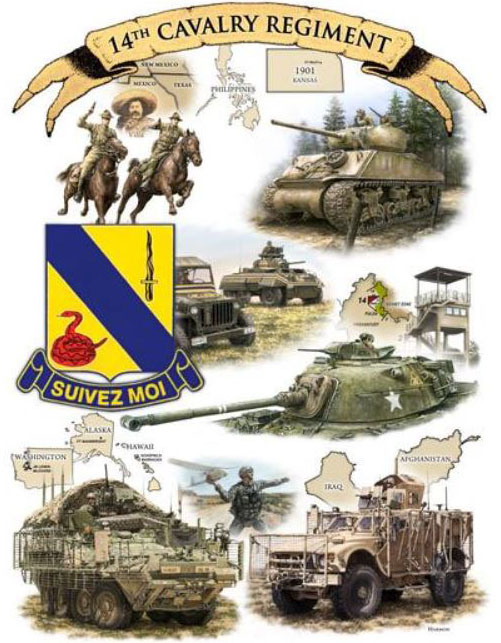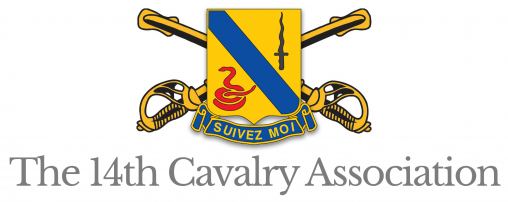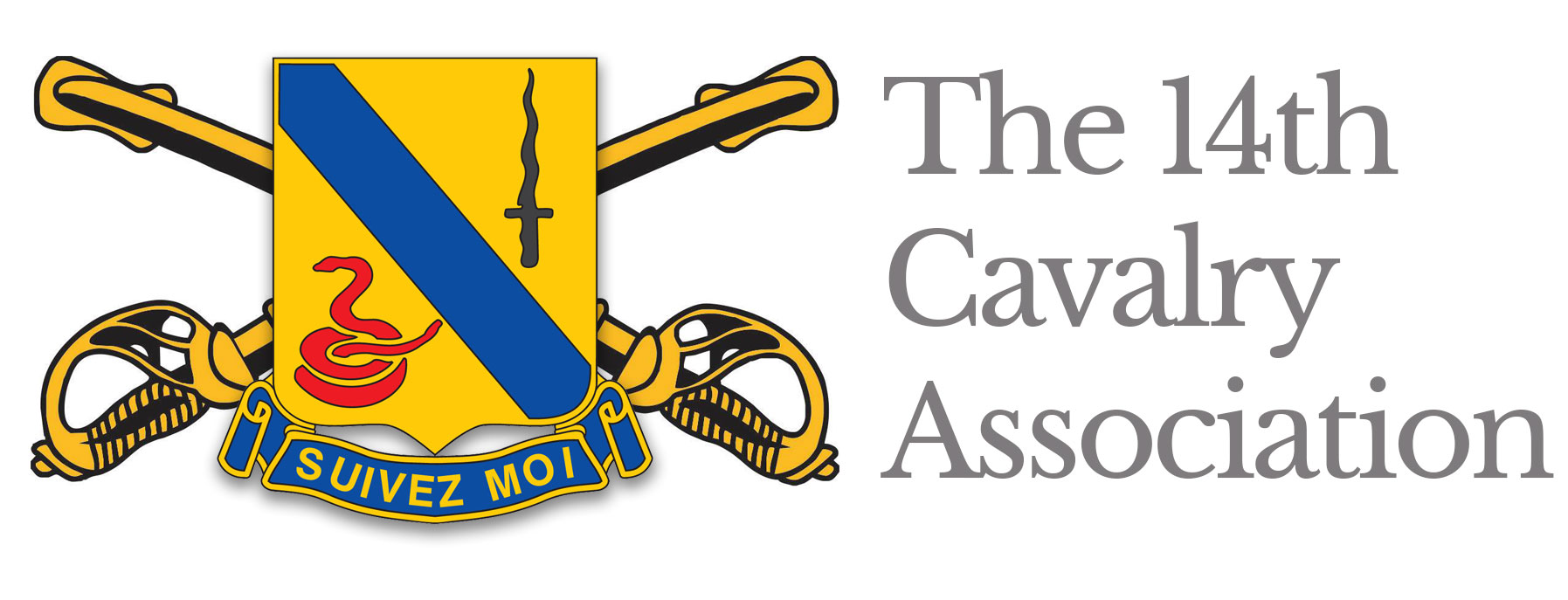by former Captain Richard C. Eagan, USA, and Colonel Gordon T. Bratz, USA-Ret.—both veterans of the 14th Armored Cavalry Regiment

Whether mounted on horses or steads of steel, the 14th Cavalry Regiment has figured prominently in the expansion and the defense of our nation.
Since 1901, squadrons or elements of the Regiment have served seven combat tours in Iraq and Afghanistan, guarded Germany’s East-West border in the Fulda Gap for twenty-four years, fought in both Europe and the Pacific during WW II, aided U.S. Federal and local authorities in western states, patrolled the U.S.-Mexico border, and fought two multi-year campaigns in the Philippines.
The Horse Cavalry Years
The Regiment, one of the original 15 U.S. Cavalry Regiments, was constituted and organized in 1901: 2 February at Fort Leavenworth, Kansas and 5 March at Fort Riley, Kansas, respectively. There its Troopers drew nearly 600 horses and learned the basics of cavalry warfare. Within months they mounted up and occupied Forts Wingate in New Mexico, Grant in Arizona and Logan in Colorado. From the latter, 2nd Squadron’s Troops E and H escorted President Theodore Roosevelt in a parade in Denver in 1902.
A year later, the Regiment went to the Philippines to fight the first of two multi-year campaigns–the Jolo and Mindanao–in the island’s jungles against Moro insurgents until 1906. The jagged-blade Moro “Kris” knife on the Regiment’s crest is emblematic of the close-in fighting there.
From 1906 to 1909 elements of the Regiment occupied Boise Barracks, Idaho, Fort Walla Walla, Washington, and the Presidios of Monterey and San Francisco in California. The Regiment provided security for surveyors of Sequoia and Yosemite National Parks. Three majors of the Regiment became acting park superintendents. The 2nd Squadron aided authorities and citizens after the 1906 earthquake and fire in San Francisco. In September 1909, the 1st Squadron escorted President Taft in a parade in Spokane, Washington.
In 1912, the Regiment began patrolling nearly 850 miles of the Texas-Mexico border from Forts Clark and McIntosh and 16 smaller Texas camps to protect Americans from Mexican bandits. The coiled snake on the Regiment’s crest is symbolic of its border duty.
In May 1916, the Regiment and 14 other Cavalry regiments under Gen. “Black Jack” Pershing, penetrated some 170 miles into Mexico against Poncho Villa–the largest horse-mounted U.S. Cavalry campaign–and destroyed his forces. In early 1918, the 14th went to Camp Travis, Texas, to prepare for World War I duty. However, the war ended before deploying and the Regiment resumed patrolling along the Rio Grande until 1919.
That year, the Regiment occupied Fort Sam Houston, Texas. In April 1920, it began a march of nearly 1,100 miles to Fort Des Moines and Camp Dodge, Iowa, and Fort Sheridan, Illinois.
From those posts it trained Army Reserves, escorted President Hoover in Des Moines in October 1932, conducted Civilian-Military Training Camps, and a Cavalry riding school at Fort Des Moines where, in 1936, the 2nd Squadron taught future president, Ronald Reagan, how to ride horses.
The Regiment moved to Fort Riley in May 1940. There it reorganized into motorized and mechanized units and trained for World War II, drawing to close its 41 years as a horse Cavalry Regiment. Slideshow of 14th Cavalry Regiment (Horse)
Steel Horses: WW II
In July 1942, the Regiment formed the nucleus of the 14th Armored Regiment, with the 14th and 711th Tank Battalions, in the 9th Division at Fort Riley. A year later the Regiment was renamed the 14th Cavalry Group (Mechanized) with attached 18th and 32nd Cavalry Reconnaissance Squadrons, 14th Tank Battalion, a tank destroyer company, and an artillery battalion. On 28 August 1944, the Group, minus the 711th Tank Battalion, deployed to Scotland. The 711th went to the Pacific Theater.
On 26 September 1944, the Group crossed the English Channel and landed on Normandy’s Omaha Beach. It then pressed east through St. Lo, Versailles, Paris, Chateau-Thierry, and Verdun to the Belgium-German border where it guarded the historic Losheim Gap nearby Bastogne, Belgium, in early December.
On 16 December, the German Army launched its final bid for victory, the Ardennes Offensive, better known as the “Battle of the Bulge” near Bastogne. The Group repelled repeated attacks until relieved and refitted. Five days later it rejoined the battle as a screening force on the southern flank.
Nearby, the 14th Tank Battalion defended the convergence of six paved roads into St. Vith, a town of about 2,000 pro-Germans on a low hill 12 miles from Bastogne, against two German infantry regiments. During eight days of constant battle, the Battalion denied the vital junction from capture by the Germans.
In January 1945, the Group, then attached to the XVIII Airborne Corps, attacked eastward and pushed the Germans back to their western defenses at the Siegfried Line of WWI. On 6 February, the Group, attached to the 1st Infantry Division, attacked through the Huertgen Forest toward Cologne.
On 7 March, the 14th Tank Battalion and 9th Armored Division captured the Ludendorf Bridge at Remagen, the last standing over the Rhine River.
Its capture allowed the Allied Forces to enter Germany’s heartland. In April, the Group advanced 250 miles toward Salzburg, Austria, attacking the retreating German Army, capturing thousands of German soldiers, and liberating thousands of allied POWs. On 8 May 1945–Victory in Europe (VE) Day–the Group halted on the banks of the Inn River at the Austrian border.
In the Pacific, the 711th Tank Battalion, with the 7th Infantry Division, landed by LSTs on 4 February 1945, at Leyte, Philippines, and later on Okinawa, part of Japan’s Ryukyu Islands. At both locations it battled dug-in Japanese forces in rugged mountainous jungle terrain until September 2 when Victory over Japan (VJ Day) was declared. Slideshow of 14th Cavalry in World War II
The Constabulary
The U.S. Constabulary, a unique security and policing force, was created in November 1945 in Germany to bring order, security, and stability to the American Zone of Occupation.
In May 1946, the 14th Constabulary Regiment, consisting of the 6th, 10th and 27th Reconnaissance Squadrons was activated. This carefully selected, highly-trained unit was equipped with M8 or M38 armored scout cars with a turret-mounted 37mm gun, M24 tanks, “Jeeps,” horses, motorcycles, and L4 and L5 aircraft.
The Regiment patrolled and manned control points along a 200-plus mile trace of the East-West German Inter-Zonal Border and aided German law enforcement agencies conduct investigations and raids, suppress disorder, and arrest suspects and violators of Occupation Force and German laws.
During the Berlin Airlift, 1948-1949, and in response to the growing threat of Soviet aggression, the Constabulary evolved into a more formidable combat-ready force.
The Armored Cavalry Regiment and the Cold War
On 20 December 1948, the 14th Tank Battalion and the 6th, 10th and 27th Constabulary Squadrons became the 14th Armored Cavalry Regiment. It was headquartered in Kitzingen with its 1st Battalion in Fritzlar, 2nd in Schweinfurt, and its 3rd Battalion in Coburg.
In May 1951, the units moved closer to the East-West German border in the Fulda Gap area, an historic terrain feature of advancing armies dating to Napoleon’s “Battle of the Nations” in 1813. The 2nd and 3rd Battalions occupied Bad Kissingen (Daley Barracks) and Bad Hersfeld (McPheeters Barracks), respectively. In August, the 1st Battalion occupied Fulda (Downs Barracks) where it was joined in January 1952 by the Regimental headquarters.
In May 1960, the battalions and companies were renamed squadrons and troops. At that time, squadrons had a Headquarters Troop, a tank troop with 17 tanks and three reconnaissance troops, each with 15 jeeps for scouts, nine tanks, and six tracked carriers for infantry and 4.2 mortar squads, directly supported by a 105mm self-propelled artillery battery. They also were supported by regimental aviation, combat engineer, military intelligence, medical, and ordnance companies or detachments. All elements were uploaded 24/7.
The highly mobile and flexible units provided reconnaissance, security and a delay-defend force along the border–opposite East German and Soviet 8th Guards Army forces–and westward to the Fulda River. Each squadron manned observation and listening posts (OPs/LPs) and conducted ground and air patrols along a 385-mile stretch of the border day and night. Stationary and mobile scouts and aerial observers could call for rapid reaction ground or heli-borne forces.
OP Alpha, in the 1st Squadron sector, began as a tactically concealed ground OP. It became a 20-foot wooden tower, and still later, a higher steel and concrete structure with sophisticated observation and sensing devices.
The Regiment maintained a high state of readiness through rigorous individual and unit training, frequent field maneuvers, and unannounced monthly alerts that required moving to simulated battle positions. It served continuously on “Freedom’s Frontier” against potential communist aggression for 24 years. Until inactivated in May 1972, the Regiment was the only unit that did not redeploy after the end of WW II—it served in Europe longer than any U.S. Army combat unit. Slide show of the 14th Armored Cavalry Regiment in Germany.
14th Cavalry Today
The Regiment was reactivated September 15, 2000, at Ft. Lewis, Washington (Joint Base Lewis-McChord [JBLM] since 2010). Its 1st Squadron became part of the Army’s first-ever Stryker Brigade Combat Team. Three more squadrons were later formed. All were Reconnaissance, Surveillance and Target Acquisition (RSTA) squadrons.
Each had highly mobile, rubber-wheeled, armored Stryker combat vehicles outfitted with various direct and indirect fire weapons, unmanned aerial vehicles, and sophisticated communications and surveillance systems that allowed day and night connectivity with all elements on the modern battlefield.
The 2nd Squadron formed May 16, 2002, at Ft. Lewis; the 4th in November 2003 at Ft. Wainwright, Alaska; and the 5th on October 13, 2005, at Schofield Barracks, Hawaii. The 2-14 was reflagged 4-2 Cavalry in June 2006 and in December that year 4-14 became 5-1 Cavalry and 5-14 was reflagged 2-14 Cavalry.
Three squadrons, with their parent brigades, fought in the Global War on Terrorism (GWOT) in Iraq and Afghanistan seven times in nine years.
1-14 deployed from JBLM on October 30, 2003 to Kuwait and crossed into Iraq in mid-November in support of Operation Iraqi Freedom I and II to fight in Samara, Tal Afar, Balad, and Mosul until October 2004. That month, 2-14 took over that area and handed it off to 4-14 in October 2005. 1-14 returned to Iraq in both 2006 and 2009 to fight in Baghdad and Ad Diwaniyah. In 2010, 2-14 deployed to Iraq’s Diyala Province in support of Operation New Dawn.
A year later, 1-14 deployed to Afghanistan’s Uruzgan and Zabul Provinces and the Horn of Panjwai where it fought until 2012 as part of Operation Enduring Freedom.
During the deployments, 24 soldiers assigned or attached to the squadrons were killed in action.
In 2016, the 1st and 2nd Squadrons reorganized. 1-14 now has three Scout Troops, an Anti-Tank Troop, a Forward Support Troop, and a Headquarters and Headquarters Troop. Each Scout Troop has two platoons of 36 Scouts and six Stryker vehicles with 50 cal. machine guns, 40mm belt-fed automatic grenade launchers, multiple dismounted Javelin (shoulder-launched, fire-and-forget, Anti-Tank missile) systems and two Stryker-mounted 120mm mortars. The Anti-Tank Troop has six platoons: three with Anti-Tank Guided Missiles with turret-mounted Tube-Launched Optically Tracked Wire-guided or Wireless (TOW) missiles and three with 105mm Mobile Gun Systems. The squadron has conducted command and staff visits with Army units of the Republic of Korea. It is part of a Stryker Brigade Combat Team at Joint Base Lewis-McChord, Washington.
2-14 has a Headquarters and Headquarters Troop, two mounted Reconnaissance Troops, one dismounted Reconnaissance Troop, and a Forward Support Troop. The mounted Reconnaissance Troop has 13 up-armored High Mobility Multipurpose Wheeled Vehicles with the TOW missile system, heavy and medium crew-served weapons, 40mm grenade launchers, 120mm mortars, anti-armor weapons, and small arms. The dismounted Reconnaissance Troop has a sniper section, light crew-served weapons, 40mm grenade launchers, shoulder-launched fire-and-forget Anti-Tank missiles, 60mm mortars and assorted small arms. The Squadron has conducted command and staff visits with army units in Australia, India and South Korea. It is part of an Infantry Brigade Combat Team at Schofield Barracks, Hawaii.
See Slideshow of Cavalry Squadrons assigned to Brigade Combat Teams

